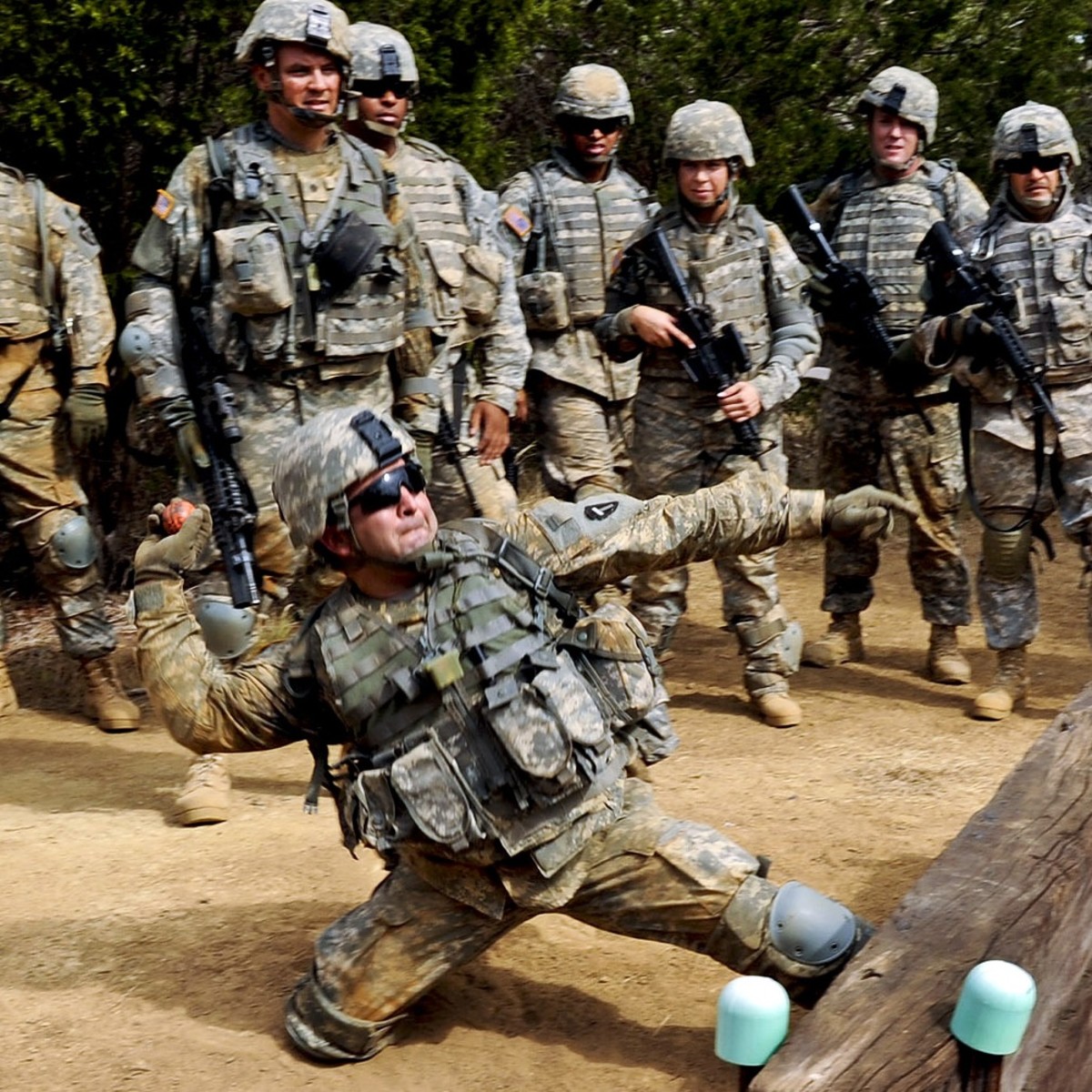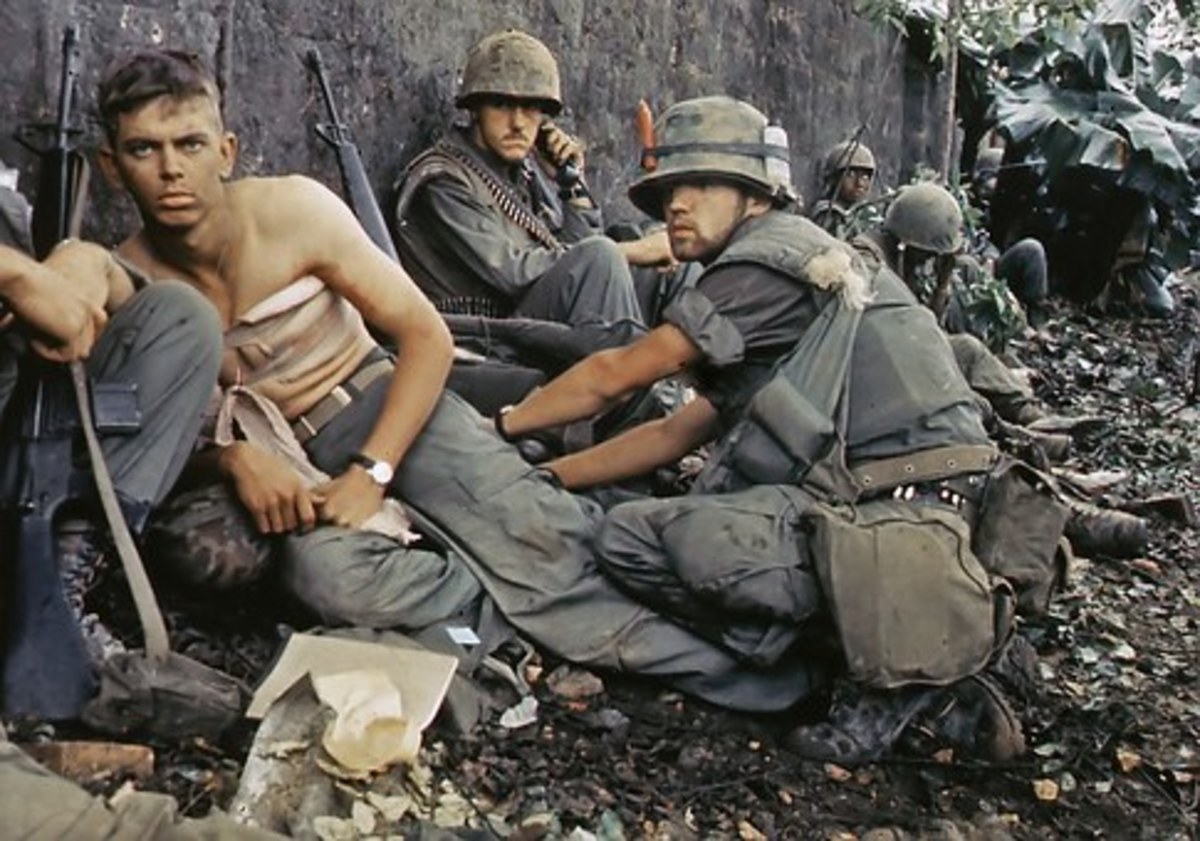Why is the Military Still Having a Problem with Sexual Assault
Figure 1
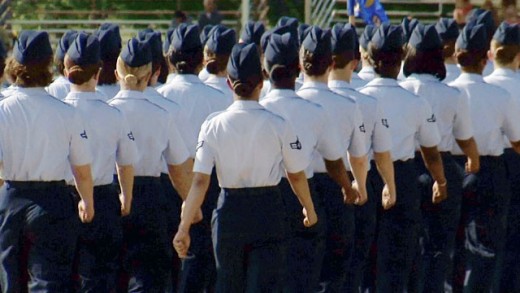
“To describe the rapist as oversexed is not only an oversimplification but not at all accurate.”
A. Nicholas Groth
In late 2004 I was a part of a team that was quickly assembled and flown around on a C-130 to Air Force Reserve Command (AFRC) installations.Our mission was to review the processes the bases had in place to respond to sexual assaults on their installation, and how they would react if a member was assaulted while on a temporary duty status away from their home installation.The inspection was organized in response to sex scandals at military installations worldwide, including two dozen reports of sexual assault at Sheppard Air Force Base, TX.As a result of the visits and other studies, a number of changes were put in place that were designed to help prevent sexual assaults and to provide a better support system for the targets of the assault.
So, it is a little disheartening, but not really surprising to read in the summer of 2012, “The number of instructors at a Texas Air Force base under investigation in a widening sex scandal has increased from 12 to 15 and the number of alleged victims has also gone up by seven to 38, officials said Thursday.[1]”The military is no stranger to issues of sexual assault on service women by service men.A recent Department of Defense (DoD) report states that, “in fiscal 2011[2], there were a total of 3,192[3] reports of sexual assault involving service members as either victims or subjects. This represents a one percent increase in reports of sexual assault compared to fiscal 2010.[4]”Sexual assault is a serious issue for the services in general; the trainees at basic military training installations are especially vulnerable. As such, this article is going to focus specifically on the issues that come with basic training units and their relationships with Drill Instructor (DI).[5]The primary question to be answered is, after all the effort that has gone into awareness training, prevention and response, why does the problem still exist?
The first step in this process is to define the subject of discussion.To the DoD sexual assault is, “Intentional sexual contact characterized by use of force, threats, intimidation, or abuse of authority or when the victim does not or cannot consent. Sexual assault includes rape, forcible sodomy (oral or anal sex), and other unwanted sexual contact that is aggravated, abusive, or wrongful (including unwanted and inappropriate sexual contact), or attempts to commit these acts.[6]”Which is a different level of intensity than sexual harassment, which is defined by the EEOC as, “Unwelcome sexual advances, requests for sexual favors, and other verbal or physical conduct of a sexual nature constitute sexual harassment when this conduct explicitly or implicitly affects an individual's employment, unreasonably interferes with an individual's work performance, or creates an intimidating, hostile, or offensive work environment.[7]”Even though both definitions have as a component sexual contact, there is a level of violence or threat of violence associated with assault that is not a part of sexual harassment.
[1]AP Wire. Huffington Post. Lackland Air Force Base Sex Scandal: More Under Investigation In Widening Controversy.http://www.huffingtonpost.com/2012/07/26/lackland-air-force-base-scandal_n_1708201.html. Posted July 26, 2012. (accessed August 13, 2012)
[2] Fiscal year 2011 October 1, 2010 to September 30, 2011
[3] As of September 30, 2011., there were 214,098 women on Active Duty and 191,571 in the National Guard and Reserve.Source: www.womensmemorial.org. (accessed August 12, 2012)
[4]U.S. Department of Defense. Office of the Assistant Secretary of Defense (Public Affairs) News Release. No. 270-12. DOD Releases Annual Sexual Assault Response and Prevention Report. http://www.defense.gov/releases/release.aspx?releaseid=15185. April 13, 2012. (Accessed August 7, 2012)
[5] When I went through Basic they were called Drill Sergeant
[6] Department of Defense DIRECTIVE NUMBER6495.01. Sexual Assault Prevention and Response (SAPR). https://egov.eeoc.gov/eeo4/pdf/EE04Form_Instructions.pdf . page 18. January 23, 2012. (Accessed July 31, 2012)
[7]U.S. Equal Employment Opportunity Commission. Facts About Sexual Harassment. http://eeoc.gov/eeoc/publications/fs-sex.cfm. (accessed August 2, 2012)
The Power Rapist
In 1979, psychologist, Dr. Nicholas Groth, along with H. Jean Birnbaum, wrote Men Who Rape: The Psychology of the Offender, in which he developed a theory which established three categories of rape, Power, Anger, and Sadistic. Of the Power rapist he said, “In these assaults, it is not the offender’s desire to harm his victim but to possess her sexually…..His goal is sexual conquest, and he uses the amount of force necessary to accomplish this objective. His aim is to capture and control his victim.[8]” The events that happened at Lackland AFB TX and other training locations in the past would fall into to the Power category. The victims were not physically beaten into submission, rather they were trapped in situations were submission and resistance was not an option for them.
In 2001, Rachael D. Berger, wrote a piece for The National Center for Women and Policing, which further defined the theory of the Power Rapist, “There are two types of Power Rapists, the Power Reassurance Rapist and the Power Assertive Rapist. These men are convinced of their sexual prowess. Power rapists show less aggression in both sexual and non-sexual situations than other kinds of rapists. They do not use unnecessary force beyond what is necessary to achieve the rape. They exhibit anger only in response to victim resistance, but will use any amount of force necessary to accomplish their goal. This may include verbal intimidation, use of a weapon, or actual physical force. However, they will sometimes run away if the victim screams or fights back. They do not want to harm the victim physically, but rather to own her sexually and achieve sexual submission. In cases where such power rapists know their victims, they use the relationship to satisfy their immediate needs, without caring how this will affect the victim.[9]” The reports coming out of Lackland are depictive who is using sex to show that he has control over a victim whom they have had time to study. The extended exposure enables the offender to select the target who potentially will offer little resistance.
A person with this sort of tendency would be attracted to the kind of position as a DI. The role of a DI and basic military training in any service is the same. According to a study by the Borden Institute, “The US Air Force, Army, Marine Corps, and Navy each have separate basic training facilities, but the services have the same goal for basic training. They attempt to transform civilian recruits into motivated, disciplined airmen, soldiers, sailors, and Marines who are trained and able to perform basic military skills in any assignment. This transformation results from the total immersion of recruits in the basic training environment. Basic training is an intensive, comprehensive process that transforms civilians into service members by inculcating military values and teaching military skills.[10]” There are very few careers[11] that have such an intensive or sustained exercise of power over an individual. While the military training environment lends itself to the predatory behavior, that is not to say that every male DI is a rapist and it is not to say the environment itself is to blame. It is saying that it is a structure, once manipulated, creates a situation for this behavior to flourish outside of the light.
[8] Groth, A. Nicholas with H. Jean Birnbaum. Men Who Rape: The Psychology of the Offender. Plenum Press. New York. Page 25
[9] Berger, Rachael D. The NationalCenter for Women and Policing. A National Training Manual for Law Enforcement. The NationalCenter for Women and Policing. Successfully Investigating Acquaintance Sexual Assault.Page 3. http://www.womenandpolicing.org. Copyright © 2001 (Accessed July 30, 2012)
[10]Broadhurst, Laurel, MD, MPH; K. Mills McNeil, MD, MPH, PHD; Rose Marie Hendrix, MD, MPH; James Wright, MD; AND Laurel Mary, MD, MPH. Military Preventive Medicine: Mobilization and Development, Vol 1 Chapter 8, THE BASIC TRAINING ENVIRONMENT. The Borden Institute. Page 170. http://www.bordeninstitute.army.mil/published_volumes/mpmVol1/PM1ch8.pdf. 2003. (Accessed July 31, 2012)
[11] Prison guard are another example
Figure 2:
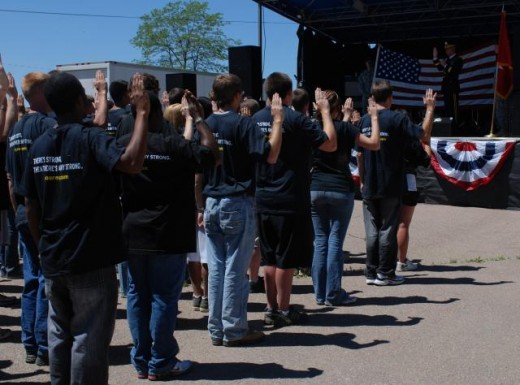
The Oath of Enlistment
This piece is looking at three aspects of the military indoctrination process which are critical to the transition from a civilian to soldier and at the same time create an operable environment for the power rapist. The requirement to follow orders, which is established with the oath of enlistment, a system of surveillance and team work execution through Drill and Ceremony (D&C).
A key component of military service that is manipulated by the rapist is trust that a service member has to have in the leadership appointed above them. During the course of their service soldiers will be ordered to perform tasks that are inherently dangerous. Leadership and their fellow soldier depend on the fact that these lawful orders will be carried out. New troops are trained to obey the lawfully given orders of those appointed over them. This starts with the oath of enlistment.
I, _____________do solemnly swear (or affirm) that I will support and defend the constitution of the United States against all enemies, foreign and domestic; that I will bear true faith and allegiance to the same; and that I will obey the orders of the President of the United States and the orders of the officers appointed over me, according to the regulation and the Uniform Code of Military Justice. So help me God.[12]
Even before they report to their basic training units, the new inductees are required to swear that they will follow the orders of those appointed over them. This respect and allegiance to NCOs and Officers is an essential component of military service. The NCO is the key instrument for the implementation of the policies of the military. They are the ones who have the primary responsibility for the continuing education of the soldiers. Foucault looks at the NCO as a sort of middle manager, "It can be clearly seen in the army, when it becomes necessary to create a corps of NCO's sufficiently competent to marshal troops effectively in tactical maneuvers which were often difficult".[13] It gives the legitimacy to the DI to exercise power over a trainee. It helps to create a scenario where a female trainee will, without question, report to an empty building with a male DI. Something she may not have done before outside of that environment.
[12] Taken from the enlistment contract of the United States military
[13] Foucault, Michel. Edited by Colin Gorden Power/Knowledge. Pantheon Books, New York 1980.
page 157
Figure 3
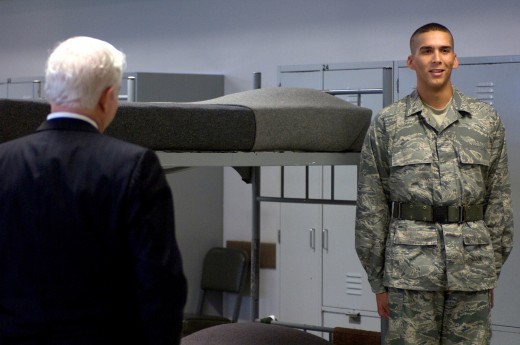
A System of Surveillance
The first thing that new trainees lose upon arrival to the basic training unit is their first name and, for the most part, last name. They will be referred to as Trainee, because they have not "earned the right” to be called “soldier" (or airman, sailor, etc.) This action is important for a number of reasons. It takes away the previous constructed idea of self or identity of the individual and replaces it with a different construction of self. It is a transformation process of the person with a civilian identity to a part of a military team. Being accepted as a viable part of the team becomes the priority. The trainee does not want to be singled out as a non-team player, because they have seen the consequences of nonconformance.
At the basic training unit the trainees are introduced into a management system that will watch over them 24 hours a day. Every activity that happens is monitored by someone in authority. The French Philosopher Michel Foucault said that they were being subjected to, "An inspecting gaze, a gaze which each individual under its weight will end by interiorizing this surveillance to the point that he is his own overseer, each individual thus exercising this surveillance over, and against, himself."[14] The production of a self-monitoring force is one of the reasons for the existence of the basic training unit. A unit that self-monitors itself to the point that each member knows and can predict the actions of the other members will perform as a cohesive unit in battle.
The design of the basic training barracks lends itself to the objective of keeping a constant gaze over the trainees. For the Air Force, the dorm rooms are open bays that hold 55 to 58 recruits with no doors. The DI can walk down the hallway and see everything that is happening in the barracks. They do not even have to walk into the rooms because the way the buildings are designed, sound carries down the hallways. So all the DI has to do is sit in their offices and listen. If the trainees start to get out of hand, the DI can step in and take control, or sit back and let things work out themselves. The design of the buildings ensures that the trainees cannot get any privacy, even in the showers or the latrines.
[14] Foucault, Michel. Editor Colin Gorden. Power/Knowledge: Selected Interviews and Other Writing: 1972-1977. Pantheon Books. New York. 1980. page 155
Figure 4
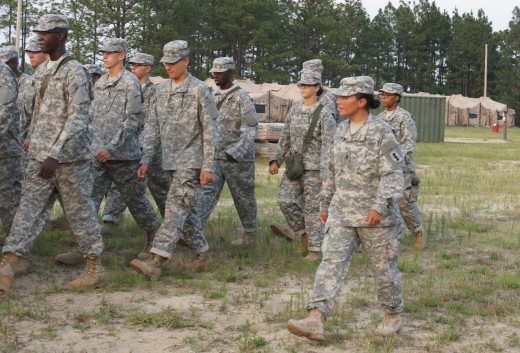
Drill and Ceremony
The first two weeks of basic training is where the foundation of military discipline is laid. When I entered basic training we affectionately referred to this period of time as “Total Control”. To the trainee it often appears as if there is nothing that they are doing correctly. A level of stress is calculated into the process, “Stress management is an essential aspect of basic training. Some stress is necessary to prepare recruits to operate effectively in the high-anxiety conditions of combat.[15]” It is during this time that the civilian is broken down and the process of building the soldier begins. During this time the new recruits learn how to march, Drill and Ceremony (D&C) fills most of the days and nights of the trainees. D&C serves as a vehicle for getting the new trainee adjusted to the way that the military does business. To the Marine Corp, “The object of close order drill is to teach Marines by exercise to obey orders and to do so immediately in the correct way. Close order drill is one foundation of discipline and esprit de corps.[16]"
Every action, drill, or movement has been calculated and thought out to get the desired results, which is a well disciplined soldier. Foucault theorized that, "The chief function of the disciplinary power is to "train", rather than to select and to levy; or, no doubt, to train in order to reduce them; it seeks to bind them together in such a way as to multiply and use them.”[17] The chief function of all the activities during basic training is to get the individual to lose their identity and function as a part of a team.
[15] Laurel Broadhurst, MD, MPH; K. Mills McNeill, Md, MPH, Phd; Rose Marie Hendrix, MD, MPH; James Wright, MD; and Laurel May, MD, MPH. Military Preventive Medicine: Mobilization and Development, Vol 1 Chapter 8, THE BASIC TRAINING ENVIRONMENT. The Borden Institute. Page 170. http://www.bordeninstitute.army.mil/published_volumes/mpmVol1/PM1ch8.pdf. 2003. (Accessed July 31, 2012)
[16] Department of the Navy. HEADQUARTERS UNITED STATES MARINE CORPS. MARINE CORPS DRILL AND CEREMONIES MANUAL. http://www.marines.mil/news/publications/Documents/MCO%20P5060.20%20W%20CH%201_1.pdf. page v. May 5, 2003. (Accessed August 7, 2012)
[17] Foucault, Michel. Discipline and Punishment. Random House Inc. New York. 1978. page 170
The DI
There is another famous aspect of basic training that almost everyone is familiar with, the image of the screaming, cursing DI. Most people who did any time in the military may forget many things that happened during their tour of duty, but very few will ever forget their DI. This person, more than anyone else, is responsible for the final product of basic training. They are the one that apply the pressure to see how far the soldier will go, then push them to a little farther. They purposely make a lot of noise and apply extreme pressure to the trainee, to get the trainee ready for an environment that they may have to operate and survive in. A member of the DI staff is with the trainees 24 hours a day, 7 days a week. The exposure to the DI is so complete that is seems odd when the DI is not present.
The DI is working with impressionable young men and women and they have a perceive authority that many new recruits have never encountered before. Combine that with a system that is designed to install good military order and discipline. If a person were to abuse the trust of the system they would have many opportunities to get a trainee in a compromising position. Constant vigilance has to be part of the plan because sexual assault in the military is not going to go away. The move by Senator John Cornyn of Texas, who stated that he was putting on hold on the nomination of Gen. Mark Welsh as the Air Force Chief of Staff "until I feel the Air Force is adequately addressing the unacceptable situation at Lackland and taking corrective steps to reform their training program to prevent this from happening again[18]" in part is an unattainable goal. One of the reasons that the military is not able to completely prevent sexual assault from happening in the future comes from the fact that it draws from society to fill its ranks. As long as there are those who will resort to sexual assault in the community, they will exist in the military.
[18] Azdailysun.com. Associated Press. Posted: Thursday, August 2, 2012 9:19 pm. Texas Air Force instructor gets 30-day sentence. http://azdailysun.com/news/national/witness-describes-surveillance-at-air-force-base/article_1e0004be-0599-597e-a456-785ef190e08f.html#ixzz22dUko3Ur. (accessed August 5, 2012)
Bigger Than the Military
Problem to be addressed is much broader then just the military, according to a CDC fact sheet “20% to 25% of women in college reported experiencing an attempted or a completed rape in college.[19]” This statistic is relevant because it is a comparative age group as new recruits into the military. It is also true that about 15% of all reported sexual assault victims are male and they are usually not homosexual. Take that figure and combine it with the fact that sexual assault is one of the least reported crimes in America. Some optimistic guesses claim that 36% of female sexual assaults are reported, while others put the number around 5%. Even with these numbers, women are more apt to report the crime than men. Military leaders can not start to think that they have solved the problem with a new program or surveillance system. Just like any human relations issue, people who want abuse the system will continue to enter the military and they will learn from those that got caught before them. A level of surveillance has to be maintained not only of the trainees but of the trainers as well.
In the past couple of decades there have been a number of sexual assault cases have risen to grab the attention of national news outlets. In 1991 the Navy/Marine Corp made the news for the incidents at the annual Tailhook Convention. In 1996 it was the Army’s turn with the scandal on their training base at Aberdeen, MD. Air Force Academy was highlighted in sexual assault scandal in 2003. After each of these events a number of changes were implemented and then the story faded from the headlines. The problem did not go away, just the headlines. What traditionally happens is for the first year or two after an event like Lackland the spot light will shine intently on the process. As time passes, the event starts to lose its significance and once that happens, cracks in the program begin to be taken advantage of again. Then slowly a new system of abuse starts to take root again. To reduce the number of incidents, swiftly addressing the allegation, care for the victim, and continued training cannot be pushed to the sidelines.
When I first walked off the bus at Ft Leonard Wood MO, in June of 1980 I had a fairly decent understanding that what I was about to go through was going to be difficult and challenge me in ways that I had never been challenged before. The moment I meet my DI, a tall SOB from OK, I began to wonder if I had made the right choice. As difficult as it was, I did not have the additional challenge of worrying if my Drill Sergeant was going to rape me. The focus of new recruits has to be successfully graduating basic training, learning how to work as a team and survive on the modern battle field. The roll of basic training is in part to create a self policing force, that gaze needs to be expanded to include the trainers as well, the challenge is to balance observation and the ability of the DI to complete their mission.
People such as conservative commentator, Liz Trottra, claim that funds expended on the prevention and response to incidents of sexual assault is not in the interests of the U. S. "You have this whole bureaucracy upon bureaucracy being built up with all kinds of levels of people to support women in the military who are now being raped too much[20]" when the interviewer challenged this position by arguing the “programs are necessary to protect those victims. Trotta responded that the purpose of the military is "to defend and protect us, not the people who were fighting the war.[21]" There is a fundamental misunderstanding on the part of Ms. Trottra about the military; they take care of their own. Service members, if they are expected to give their all have to believe that the Service will take care of them if needed.
Ms. Trottra also claimed the reported incidents of sexual harassment were proof positive that men and women could not serve in close quarters for an extended period of time. In defending her position she stated, "the environment of combat by definition sets up a situation where basic instincts rule. The niceties of male, female interaction fade in this arena and any scientist will tell you that testosterone rules.[22]" In the 1950s when racial barriers began to crumble in the military there was resistance and issues to overcome, but there was no going back to the old segergated system. With gender integration into career fields where women were traditional barred from, there is resistance to change and issues to be worked through, but again, there is no going back.
[19] Center for Disease Control (CDC). Sexual Violence Facts At A Glance Spring 2008. http://www.cdc.gov/violenceprevention/sexualviolence/. (accessed August 10, 2012)
[20] Huffington Post. Fox News' Liz Trotta On Women Raped In Military: 'What Did They Expect? These People Are In Close Contact'. http://www.huffingtonpost.com/2012/02/13/fox-news-liz-trotta-rape_n_1274018.html. Posted: 02/13/2012 2:50 pm Updated: 02/13/2012 8:25 pm. (accessed July 31, 2012)
[21] IBID
[22] Shapiro, Rebecca. The Huffington Post. Fox News' Liz Trotta Doubles Down On Statements About Rape In The Military. http://www.huffingtonpost.com/2012/02/20/fox-news-liz-trotta-rape-military_n_1288769.html. Posted: 02/20/2012 10:24 am Updated: 02/21/2012 9:50 am. (accessed August 13, 2012)
Picture Sources:
Figure 1 Mone, John AP Photo. Huffington Post. Lackland Air Force Base Sex Scandal: More Under Investigation In Widening Controversy. http://www.huffingtonpost.com/2012/07/26/lackland-air-force-base-scandal_n_1708201.html. Posted July 26, 2012. (accessed August 13, 2012)
Figure 2 Edwards, Shameka.4th Infantry Division Public Affairs Office. Recruits take oath of enlistment at Fort Carson. http://www.army.mil/article/41631/Recruits_take_oath_of_enlistment_at_Fort_Carson/. June 30, 2010. (accessed August 13, 2012)
Figure 3 Secretary of Defense http://www.afsoc.af.mil/shared/media/photodb/photos/080724-D-7203C-008.jpg (accessed August 13, 2012)
Figure 4 Soldiers marching http://usarmy.vo.llnwd.net/e2/c/images/2011/06/14/200828/original.jpg (accessed August 13, 2012)
© 2012 Mark Monroe


